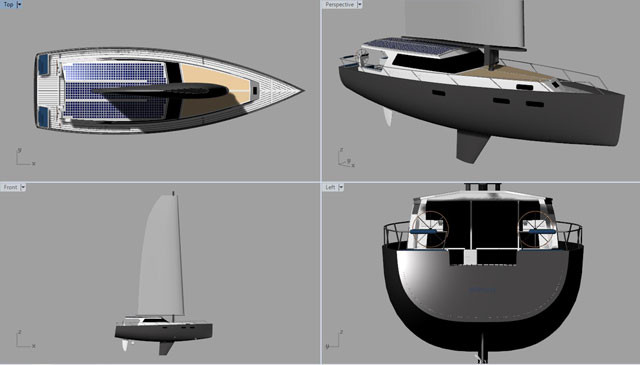Our university in partnership with a Turkish shipyard is going to build a boat propelled by renewable energy - with a hybrid solar-wind-electric propulsion. The consortium of Maritime University of Szczecin, Warsaw University of Technology, and the Autocomp company from Szczecin were allocated a EUR 1M grant for project implementation. Final assembly, launching and the boat's first cruise are planned to take place in the Marmara Sea in 2016.

The project “RepSail - Innovative yacht with a hybrid renewable energy propulsion” with a value of ca EUR 1M will be developed within the Era Net Transport programme (call: Era Net Future Travelling). In the world, there are several concepts of this kind of a boat, however there has never been a hybrid unit integrated to such an extent. An entirely new type of a light hybrid unit is to be built - one to illustrate the development directions of yacht propulsions and hulls of this type within the nearest 20 years.
The Maritime University of Szczecin is responsible for designing and building high efficiency navigation and control systems connected with propulsion system. This task consists in developing, designing and building the following subsystems:
- navigation system - based on solutions that are currently being employed in the world i.e. electronic navigation maps,
- steering system - based on built-in controllers with extended diagnostic functionalities for integrating energy sources, solar panels, wind turbines, water turbine, monitoring and control systems,
- propulsion system - including an analysis of inverters and voltage converters,
- user interactions - based on touchscreen interface and intelligent drivers.
The components, designed by, inter alia, a world-renowned business partnership AutoComp Management and comprising e.g. electric power management system, will be assembled into a laboratory version and tested. After the testing phase the components will be incorporated into the boat’s hull. Turkish shipyard Milper in Tuzla is to build the hull and propulsion and the research team from Warsaw University of Technology will work on power sources - eco-batteries.
Several meters long, 6-person boat will be built from modern composite materials and alternatively powered by renewable energy sources. The key propulsion of the boat will be wind power caught in the sails. This, however, is where the similarity with contemporary sailboats ends. For security reasons and with an aim of safeguarding full mobility in ports and water areas where using sails is not possible as well as in zero-emission zones (e.g. city centres) auxiliary propulsion will come from an efficient electric engine powered by hybrid solar cells, wind turbines and rotor systems recuperating energy from the waves. The accumulated energy will be then stored in high efficiency, environment-friendly lithium electric batteries.
In terms of renewable energy, power supply systems will consist in, inter alia, 6 to 30 active solar panels of 100 W each. For the panels to be fitted onto the boat, the upper deck will be widened up to 10-12 sq m. They will provide power necessary both for propulsion but also to other components of the boat (e.g. navigation systems). They will be adjusted to the structure of the boat and resistant to sea-related conditions. Moreover they will be possible to use without any maintenance and cleaning (thanks to titanium oxide film applied). The generated energy will be sufficient for the boat to move at the speed of 5 knots (1 knot equals to ca. 1,8 km/h) - and it will take approximately 2 hours for such system with satisfactory amount of sunlight to fully charge the batteries.
Additionally, construction of the boat incorporates harnessing wind energy. To increase the flow of a wind stream wind channels will be applied along with special spirals fitted on the hull. Kinetic energy will be converted into electrical power necessary for charging the batteries. The boat will move at the speed of 6-7 knots.
The project’s key issue is the question of accumulation and management of renewable energy. Selecting a source while generating and storing the energy may significantly improve the whole system’s efficiency (which will studied at a later phase). The batteries used in the energy storage system are to be designed in such a way so as to minimise energy loss. Sailing ships are balanced in terms of hydrodynamics - they make use of the force of the wind with minimal water resistance. To reduce the latter, the part of the boat below the waterline will be designed with a narrower bow.
—————————————————————————————————-ERA-NET TRANSPORT III (ENT III) is an international consortium with entities providing financing for research in the area of transport (ministries, governmental agencies, and research institutes). The main objective of the programme is to reduce the fragmentation of European Research Era through support and development of international cooperation in financing transport research. The programme encompasses inter alia calls for international research projects in the area of transport, offering support to entities managing national research programmes and disseminating information on national research programmes in the area of transport. The consortium comprises 24 entities from 18 countries (from Poland - National Centre for Research and Development)


